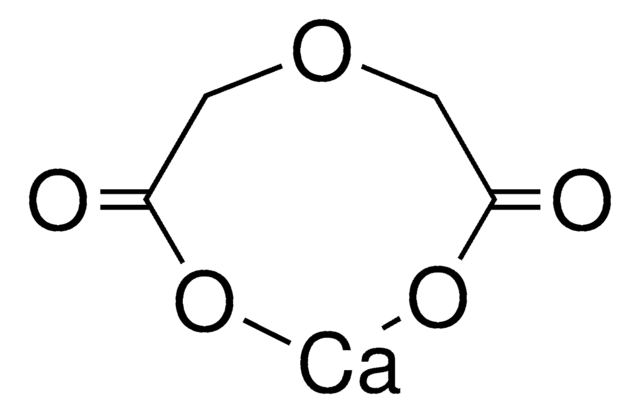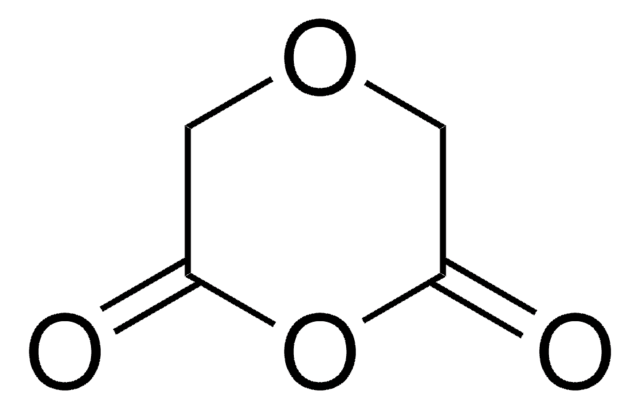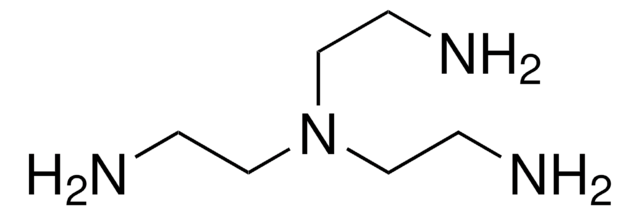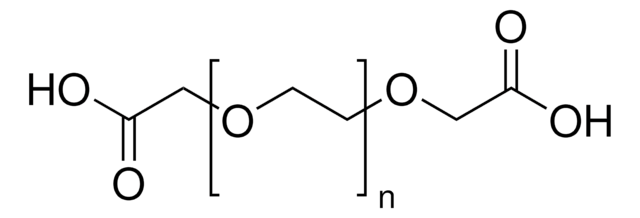143073
Diglycolic acid
98%
Synonym(s):
2,2′-Oxydiacetic acid
Sign Into View Organizational & Contract Pricing
All Photos(4)
About This Item
Linear Formula:
O(CH2COOH)2
CAS Number:
Molecular Weight:
134.09
Beilstein:
1072117
EC Number:
MDL number:
UNSPSC Code:
12352100
PubChem Substance ID:
NACRES:
NA.22
Recommended Products
Quality Level
Assay
98%
mp
140-144 °C (lit.)
solubility
ethanol: soluble 5%, clear to slightly hazy, colorless to greenish-yellow
functional group
carboxylic acid
ether
SMILES string
OC(=O)COCC(O)=O
InChI
1S/C4H6O5/c5-3(6)1-9-2-4(7)8/h1-2H2,(H,5,6)(H,7,8)
InChI key
QEVGZEDELICMKH-UHFFFAOYSA-N
Looking for similar products? Visit Product Comparison Guide
General description
Diglycolic acid is a toxic metabolite of diethylene glycol (DEG) responsible for DEG-induced proximal tubular necrosis.
Application
Diglycolic acid was used in the preparation of needle-like aragonite particles from calcium nitrate aqueous solutions.
Biochem/physiol Actions
Diglycolic acid has antithrombogenic properties and induces vasodilation. It inhibits succinate dehydrogenase activity in human proximal tubule cells.
Signal Word
Warning
Hazard Statements
Precautionary Statements
Hazard Classifications
Acute Tox. 4 Oral
Storage Class Code
11 - Combustible Solids
WGK
WGK 3
Flash Point(F)
Not applicable
Flash Point(C)
Not applicable
Personal Protective Equipment
dust mask type N95 (US), Eyeshields, Gloves
Choose from one of the most recent versions:
Already Own This Product?
Find documentation for the products that you have recently purchased in the Document Library.
Customers Also Viewed
Miriam E Mossoba et al.
Toxicology in vitro : an international journal published in association with BIBRA, 52, 87-93 (2018-06-12)
Carboxymethyl starches are added to food products for thickening or tablet binding/filling purposes. Although they lack toxicity, their synthesis creates the chemical byproduct diglycolic acid (DGA), which is difficult to eliminate and whose toxicity is in question. A rare case
Ming-Ming Yu et al.
Journal of pharmaceutical and biomedical analysis, 85, 21-27 (2013-07-23)
Controlling and minimizing the adverse effects of drugs are the key issues in ensuring the safety of drug therapy. Carboxymethyl chitosan has been widely used as an anti-adhesion material. However, recently in China there have been several reported instances of
Preparation of needle-like aragonite particles from calcium nitrate solution.
Fellner P, et al.
Acta Chimica Slovenica, 4(2), 3-10 (2011)
Greg M Landry et al.
Toxicology letters, 221(3), 176-184 (2013-07-06)
Diethylene glycol (DEG) is a solvent used in consumer products allowing the increased risk for consumer exposure. DEG metabolism produces two primary metabolites, 2-hydroxyethoxyacetic acid (2-HEAA) and diglycolic acid (DGA). DGA has been shown to be the toxic metabolite responsible
Zahraa Youssef et al.
Photodiagnosis and photodynamic therapy, 22, 115-126 (2018-03-28)
In this study, light-sensitive photosensitizers (Chlorin e6, Ce6) were linked to TiO2 and SiO2 nanoparticles (NPs) in order to develop new kinds of NP-based drug delivery systems for cancer treatment by PDT. TiO2 or SiO2 NPs were modified either by
Our team of scientists has experience in all areas of research including Life Science, Material Science, Chemical Synthesis, Chromatography, Analytical and many others.
Contact Technical Service



![2-[2-(2-Methoxyethoxy)ethoxy]acetic acid technical grade](/deepweb/assets/sigmaaldrich/product/structures/335/694/b58c539b-141f-4ab2-98d9-5f46c748490b/640/b58c539b-141f-4ab2-98d9-5f46c748490b.png)










![4-[(N-Boc)aminomethyl]aniline 97%](/deepweb/assets/sigmaaldrich/product/structures/341/155/530c425c-7e6e-435e-a28a-9d40b05b938a/640/530c425c-7e6e-435e-a28a-9d40b05b938a.png)